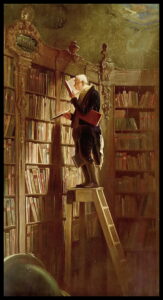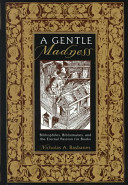
Carl Spitzweg – The Bookworm 1
How often do we become an caricature of our passions? Are we compared to those of old who are considered peculiar or strange? When we look at those who are so predisposed the following quote from John Earle’s Microcosmography satire on the Antiquary is cruelly witty and might feel too close to home. Yet we know that we are following a trail that is full of wonders and adventures and our tendencies are to Bibliophilia rather than Bibliomania! 2
He is a man strangely thrifty of time past, and an enemy indeed to his maw, whence he fetches out many things when they are now all rotten and stinking. He is one that hath that unnatural disease to be enamoured of old age and wrinkles, and loves all things (as Dutchmen do cheese), the better for being mouldy and worm-eaten. He is of our religion, because we say it is most antient; and yet a broken statue would almost make him an idolater. A great admirer he is of the rust of old monuments, and reads only those characters, where time hath eaten out the letters. He will go you forty miles to see a saint’s well or a ruined abbey; and there be but a cross or stone foot-stool in the way, he’ll be considering it so long, till he forget his journey. His estate consists much in shekels, and Roman coins; and he hath more pictures of Cæsar, than James or Elizabeth. Beggars cozen him with musty things which they have raked from dung-hills, and he preserves their rags for precious relics.
He loves no library, but where there are more spiders’ volumes than authors’, and looks with great admiration on the antique work of cobwebs. Printed books he contemns, as a novelty of this latter age, but a manuscript he pores on everlastingly, especially if the cover be all moth-eaten, and the dust make a parenthesis between every syllable. He would give all the books in his study (which are rarities all), for one of the old Roman binding, or six-lines of Tully in his own hand. His chamber is hung commonly with strange beasts’ skins, and is a kind of charnel-house of bones extraordinary; and his discourse upon them, if you will hear him, shall last longer. His very attire is that which is the eldest out of fashion. He never looks upon himself till he is grey-haired, and then he is pleased with his own antiquity. His grave does not fright him, for he has been used to sepulchres, and he likes death the better, because it gathers him to his fathers. 3
Originally published in 1628, our library has the 1897 reprint of the 1811 Dr. Bliss’s edition of Microcosmography. This is an interesting tome with descriptions of various and sundry personalities. Take a look and see who else John Earle described and see if you find other familiar characters.
Worldcat: Link
- Title: Microcosmography : Piece of the world discovered – Or, a Piece of the World Characterized; in Essays and Characters / by John Earle … A reprint of Dr. Bliss’s edition of 1811. With a preface and supplementary appendix by S.T. Irwin.
- Bristol, London: W. Crofton Hemmons: Simpkin, Marshall, Hamilton, Kent & co., ltd., 1897.
- Language: English
- Setting: Classical, Caricature
- DLWA Call Number: PR2270.E15 M5 1897
- The Bookworm (German: Der Bücherwurm) is an 1857 oil-on-canvas painting by the German painter and poet Carl Spitzweg.
- See the following Wikipedia reference for the difference between the two Link:
- Microcosmography, ibid, 1897 – Page 20.



